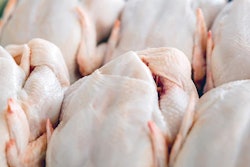
Environmental conditions during poultry processing affect the birds being processed and the plant’s workers, meaning that the needs of personnel and broilers should be fully considered to maximize output.
Good reception
Environmental conditions need to be considered from the moment broilers arrive at the plant.
Upon arrival, birds are weighed and, especially in hot climates, pass through a washing and disinfection area, to remove as much fecal matter that may have adhered to their feathers and skin and to refresh them.
After this, the trucks that have brought them from the farm are parked in the waiting area, where birds must be kept cool. There must be a good flow of air in this area to remove evaporative heat and ensure a comfortable microclimate within the stacks of caged birds.
Studies have shown that the ideal conditions comprise a temperature of 22-26 C, with relative humidity of 60 percent.
In hot climates, careful monitoring needs to be carried out to ensure that these conditions are achieved. A failure to ensure the correct environmental conditions can result in mortalities. In some cases, companies give birds supplements prior to transport to help prevent this from happening.
At this stage of operations, consideration also needs be given to workers, who should be provided with protective glasses and face masks to protect them from contaminated air. There is a risk to health at this stage due to high volume of bacteria, dust and fecal matter that may have been drawn from the birds by the circulating air.
Hanging area
Birds must be kept calm during this stage of operations, keeping stress to a minimum and so making their handling and hanging easier. Various environmental factors need to be considered to achieve this.
The hanging area needs to be dark, with only red or blue light used, which will allow workers to see without affecting the birds.
Noise must be kept to a minimum. Fans must be silent to minimize stress as, in extreme cases, stress at this stage of processing operations can result in greater volumes of blood being pumped into the wings and thighs.
For similar reasons, the breast comforter must be properly installed and adjusted, so ensuring correct contact with the breast, relaxing the birds, and preventing wing flapping.
Where staff are concerned, the air in this area must be as clean as possible but, additionally, they should be provided with air filtering mask and glasses to protect their eyes and faces from any fecal matter discharged by stressed birds.

Keeping the hanging area dark will minimize the stress experienced by broilers. (Eduardo Cervantes López)
Slaughter and bleed tunnel
Air needs to be renewed at this point if workers are to perform effectively. Additionally, they will need a good white light directed at the birds’ necks so they can be properly cut. Correct working conditions are highly important at this point if errors are to be avoided that will be become apparent later as poorly bled birds exit the stunner.
Scalding and plucking
These two operations require the surface temperature of carcasses to be raised so that the skin follicles open, allowing feathers to be more easily removed.
For this reason, the temperature in this area is usually higher than recommended for worker comfort. But room temperatures that are too high will lead workers to tire more quickly and the quality of their work may be adversely affected.
There must be at least some air movement to cool workers and, once again, good lighting must be provided to allow checks to be made to ensure that plucking meets quality standards.
Evisceration
Once birds have been slaughtered, bacterial growth will start and, if this is not quickly controlled, the microbiological quality of birds will be affected. This becomes all the more critical during evisceration due to fecal contamination.
Continuous washing with cold water is important to remove fecal matter and cool the carcasses. Similarly, air conditioning will bring down carcass temperature and slow bacterial growth.
With low temperatures, the team working in this area will also feel more comfortable.
Chilling
During chilling operations, the environmental temperature tends to be as beneficial for workers as it is for broiler carcasses.
Form a starting temperature of around 38 C, carcass temperatures drop to around 2 C after passing through the prechiller and chiller, and this will inhibit bacterial growth. The chilling environment will enable workers to perform in comfort.
Packing, cut-up and deboning
This last part of the process provides an ideal environment for carcasses and personnel.
The carcasses will arrive at this area at the same temperature at which they left the chiller. Studies have shown that at 3 C, bacteria can take 20 hours to multiply. However, when the temperature rises above 4 C, bacteria will multiply every eight hours. Because of this, environmental temperatures must be kept within the parameters set by the local health authority.

Maintaining an environment that considers the needs of broilers as well as those of workers will contribute to good performance. (Eduardo Cervantes López)

















